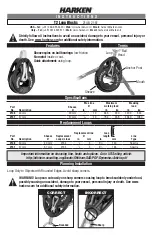
The following table lists the Current Transformers tests:
No.
Test
Test description
1
Ratio Polarity
and Burden
The ratio measurement is performed applying high current to the CT primary, and
measuring the CT secondary current. The burden can be by-passed, or left in series for the
measurement: in this instance, the voltage drop is measured. The secondary current can be
measured by a clamp.
Input parameters are the following:
•
The nominal primary and secondary current, from which the program computes
the nominal ratio
•
The nominal test current
The display shows:
•
The actual current output
•
The corresponding current input, and the value of the secondary current with the
nominal primary current*
•
Actual ratio and ratio error
•
Phase shift and polarity*
When the burden is tested, the following parameters are displayed
•
The voltage drop across the burden
•
For the burden: VA rating at the nominal current, angle, power factor
*For Non - CT transformers equipped with IEC61850-9-2LE interface, the STS reads the CT
samples output from its Ethernet interface to measure ratio and polarity
2
Burden
Secondary
Side
The burden measurement is performed applying low AC current to the CT burden, and
measuring the voltage drop.
Input parameters are the following:
•
The nominal secondary current
•
The nominal test current
The display shows:
•
The actual current output
•
The voltage drop across the burden
•
For the burden: VA rating at the nominal current, angle, power factor
3
Excitation
Curve
The excitation curve is tested connecting the high AC voltage to the CT secondary, slewing
the voltage and measuring at the same time the output voltage and current.
Input parameters are taken from the CT Nominal Values window. Other inputs are the
following:
•
Maximum test voltage and current
•
Test frequency
The test set controls the output voltage and current during the test, and stops as the knee is
recognized. The display shows the following:
•
The characteristic curve
•
The actual voltage knee and the error with respect to the nominal
•
The actual current error at knee
In addition to this, it is possible to define a point-by-point test, where:
•
It is possible to input the desired number of test points, defined with current and
voltage
•
The test result reports the deviation from the nominal values, and shows if results
are in the set tolerance
Table 41 - Current Transformers tests (1/4)
Shop for Power Metering products online at:
1.877.766.5412
www.
PowerMeterStore
.ca
















































